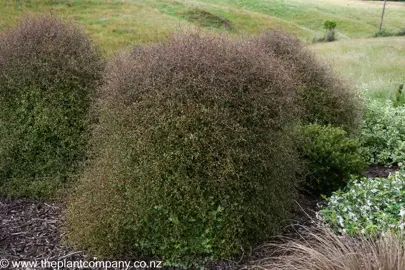Muehlenbeckia Australis Information
Muehlenbeckia australis, also known as pohuehue, large-leaved pohuehue, or large-leaved Muehlenbeckia, is a vigorous, climbing vine native to New Zealand. Here are some of its key characteristics:

Muehlenbeckia are fantastic NZ native plants. They bring texture and interest to gardens as well as having significant ecological benefits. It also serves important roles for stabilising banks and erodible areas. Our guides will empower you to grow Muehlenbeckia that will not only thrive but put on a beautiful show.
This series of articles answers many of the frequently asked questions about Muehlenbeckia, such as how fast they grow, their hardiness, and more!

Muehlenbeckia australis, also known as pohuehue, large-leaved pohuehue, or large-leaved Muehlenbeckia, is a vigorous, climbing vine native to New Zealand. Here are some of its key characteristics:
Appearance:
Growth Habit:
Habitat:
Growing Conditions:
Uses:
Overall, Muehlenbeckia australis is a vigorous and versatile plant that can be a valuable addition to gardens in suitable locations.

Muehlenbeckia astonii berries are edible and described as being sweet and juicy. They are a popular food for Birds, lizards, and rodents.

The mature size of Muehlenbeckia astonii can vary slightly depending on growing conditions, but as a a general guide it grows to 2.5 metres tall and 1.5 metres wide. Some sources report it can reach up to 3 metres tall under ideal conditions. Remember, however, that you can trim this plant to whatever size you desire. Often it is kept to 1 m tall and about 60 cm wide with once-a-year trimming.

Muehlenbeckia complexa can be invasive outside its native range in New Zealand. It's a fast-growing vine that can quickly sprawl and smother other plants. Further, it thrives in a wide range of conditions which allows it to establish easily in new environments. It can spread through seeds dispersed by birds and animals, or by its own rooting stems that come into contact with the ground. In warmer climates, it might become even more aggressive. Even within New Zealand, it can become unruly if left untamed. Be prepared for regular trimming to keep it under control!

Yes, Muehlenbeckia is native to New Zealand. There are five species of Muehlenbeckia that are endemic to New Zealand, meaning that they are found nowhere else in the world.

Muehlenbeckia astonii, commonly known as Shrubby Tororaro is an endemic, New Zealand shrub in the family Polygonaceae. It has distinctive small, heart-shaped, deciduous leaves amidst a tangle of wiry, interlocking branches. It is a hardy and adaptable shrub that can tolerate dry conditions, wind, and frost. It typically grows to 2.5 metres tall and 1.5 metres wide.
Some further details include:
If you are looking for a hardy, low-maintenance shrub that is well-suited for coastal gardens, Muehlenbeckia astonii is a great option.

Muehlenbeckia axillaris, commonly known as Creeping Wire Vine or Pohuehue is a low-growing, evergreen shrub that forms dense mats of wiry stems carrying tiny, glossy green leaves. During colder months the foliage tends to develop bronze tones. Masses of small, cream-colored flowers are borne through summer and result in small, white berries in autumn. This NZ native typically grows to 20 cm tall and 1 m wide. It grows best when planted in full sun or partial shade on a well-drained site. Further information is as follows:
Growing Conditions:
Uses:
Care:
The versatility and ease of care makes Muehlenbeckia axillaris a popular choice for gardeners and landscape designers.

Muehlenbeckia complexa, also known as maidenhair vine, creeping wire vine, lacy wire vine, angel vine, mattress vine, and pohuehue, is a vigorous, semi-deciduous vine native to New Zealand. Some of its key characteristics include:
Appearance:
Growth Habit:
Growing Conditions:
Uses:
Benefits:
Additional Information:

Muehlenbeckia is a versatile plant that can be grown in a variety of locations in the garden. It can be used as a ground cover, climber, or shrub. Here are some suggestions on how you might use Muehlenbeckia:

Creeping Pohuehue and Creeping Wire Vine is another name for Muehlenbeckia axillaris, a low-growing, evergreen shrub native to New Zealand and parts of Australia (Tasmania, New South Wales, Victoria). It forms dense mats of wiry stems with tiny, glossy green leaves. In colder months, the foliage might develop bronze tones. It produces masses of small, cream-colored flowers in summer, followed by small white berries in autumn. It typically grows up to 20 cm tall and 1 metre wide.

Maidenhair Vine is a common name for Muehlenbeckia complexa, a vigorous, semi-deciduous vine native to New Zealand. It forms a dense network of wiry, interlacing branches. These host tiny and rounded, bright green leaves resembling the leaflets of maidenhair ferns (hence the name).

Shrubby Tororaro, also known scientifically as Muehlenbeckia astonii, is a NZ native shrub. It is known for its intricate network of wiry, interlacing branches that create a unique texture. These branches are adorned with small, bright green, heart-shaped leaves.

Here are some common names for a few specific Muehlenbeckia species:
Planting Muehlenbeckia and getting them to grow well is generally easy when you get a few of the basics right. This involves planting them in the right soil type, choosing the most ideal planting position, and ensuring the plants have the essentials to thrive. The Plant Company has the right advice to ensure success when you are growing Muehlenbeckia.

Yes, some species of Muehlenbeckia can grow in partially shaded conditions. However, they will generally grow best in full sun. These species can tolerate a degree of shade:
When planting Muehlenbeckia in shade, they should still get a few hours of sun per day.

Muehlenbeckia can vary in size depending on the species and growing conditions. Some species are small and compact, while others can grow into large shrubs. For example:
Muehlenbeckia are generally fast-growing plants, and they can reach their full size within a few years. However, the growth rate of a Muehlenbeckia plant will vary depending on the species, climate, and growing conditions.

Choose a full sun position or partial shade position with good drainage for your Muehlenbeckia. The hole should be dug to at least 50-75% deeper and wider than the container the plant is currently growing in. A planting spade makes the hole digging a lot easier. The Plant Company recommends incorporating compost or sheep pellets into the soil to provide additional organic material, but this is not essential. Do not put fertiliser in the bottom of the hole, rather spread that on the soil surface after planting, and preferably do this when the plant is actively growing in spring.
Remove the plant from the container it is growing in by either pulling it free or by cutting the bag. We recommend cutting the bag, especially for larger grade plants, to minimise any chance of damaging the roots. If the roots are bound up, you can tease them apart if you want but this is not essential. The Plant Company does not advise cutting through roots, even if the plant is rootbound, as that injures the plant. Our article, Managing Rootbound Plants explains this in more detail.
Now place the plant in the hole and make sure it is level with the soil surface before filling in around it. If it is above the soil surface, dig more out. If it is below, put in more soil and retest the level. Once the plant is set level with the soil surface, add more soil gradually and firm it around the plant using gentle pressure as you go. Scatter Native Plant Fertiliser across the soil surface after planting and then give the plant a good watering.

The most important part starts with planting, and our article, How To Plant Muehlenbeckia, provides sound advice on how to do this properly. So, let’s now assume your plant is growing well and you want to keep it that way!
Winter is the perfect time for mulching your plants. Organic matter such as compost or sheep pellets should be spread liberally around the plants and then overlaid with mulch. The Plant Company has three very good options for mulch. The first is coco fibre matting which is made from the husks of coconuts. The second is Earth Mat which is made from recycled paper. Both of these break down to become part of the soil within two years. The third is black plastic matting which will last 20 years or more. Whichever mulch is used, The Plant Company recommend stones, bark chip, or other similar products be spread over top for aesthetic purposes. The Plant Company does not recommend adding fertiliser during winter as this is better applied in spring so less is wasted. However, adding organic matter such as compost is quite okay.
Spring is the perfect time for fertilising the plants as they start to bounce into life. The Plant Company has fertilisers which have been specially blended for different plants and in this instance, our Native Plant Fertiliser will give them the correct boost and keep them fed for 12-months. A suitable alternative is our organic fertiliser which will also keep them well fed but they will require a secondary application in autumn.
Summer is when the plants need regular watering and this should be undertaken every second or third day on the hottest days. Plants that are establishing need particular attention as their root system will not have penetrated deep enough to secure consistent moisture yet.
Caring for Muehlenbeckia in autumn and winter is about keeping the plants healthy. Foliar feeding using a liquid fertiliser can be undertaken during spring, summer, and autumn if you have time, but this is not essential if solid fertiliser and/or good amounts of organic matter have already been applied. If you think the plants need an extra boost or have some yellowing, however, a liquid fertiliser won’t hurt.

Muehlenbeckia generally require minimal pruning, though some pruning can be beneficial to control the size and shape of the plant. Any trimming should be undertaken when the plant is actively growing in summer as the plant will more likely sprout new shoots at this time.
The Plant Company recommends that Muehlenbeckia are first pruned to contain their size to the desired height and width. Secondly, the plant is shaped as desired. Finally, remove weak or diseased stems. With this, no more than one-third of the vegetation should be removed during this exercise.
Muehlenbeckia are incredibly resilient plants and will bounce back after trimming. Further, young plants are likely to sprout new shoots more easily than older plants. If the plant is too old, pruning will need to be less aggressive.

Muehlenbeckia require feeding to keep them growing optimally. The Plant Company’s Native Plant Fertiliser has been blended to give plants the boost they need and then sustained nutrition for the next 12 months. It is perfect for Muehlenbeckia!
We recommend the fertiliser is applied to the soil surface in spring just as the plants start to grow actively. More importantly, we advise that no fertiliser is placed in the hole at planting, but rather spread around the soil surface so it can wash through the roots as it releases. The Plant Company’s Native Plant Fertiliser ensures that nutrients remain in the soil around the plant rather than being lost through the soil profile to where the plant cannot reach it. This also applies to plants grown on sandy soils. This fertiliser is therefore very environmentally friendly and longer lasting than most other products in the market.
Foliar feeding using a liquid fertiliser can be undertaken if you have time, but this is not essential if Native Plant Fertiliser has been applied. If you think the plants need an extra boost or have poor colouring, however, a liquid fertiliser application won’t hurt. A great benefit of foliar feeding is that it helps keep the leaves strong and lush.

The ideal spot for Muehlenbeckia is one with a well-drained soil and in full sun. Muehlenbeckia do not tolerate waterlogged soil and will often fail in a short period of time. They can tolerate a wide range of conditions, including poor soil, drought, and coastal environments. They are also relatively frost hardy once established. If you are unsure about the hardiness of a particular species of Muehlenbeckia, it is best to contact us.
Whether you need assistance finding the plant you’re looking for or you simply want to know more about who we are and what we do, we invite you to get in touch with us today. A member of The Plant Company team will get back in touch as soon as possible.


